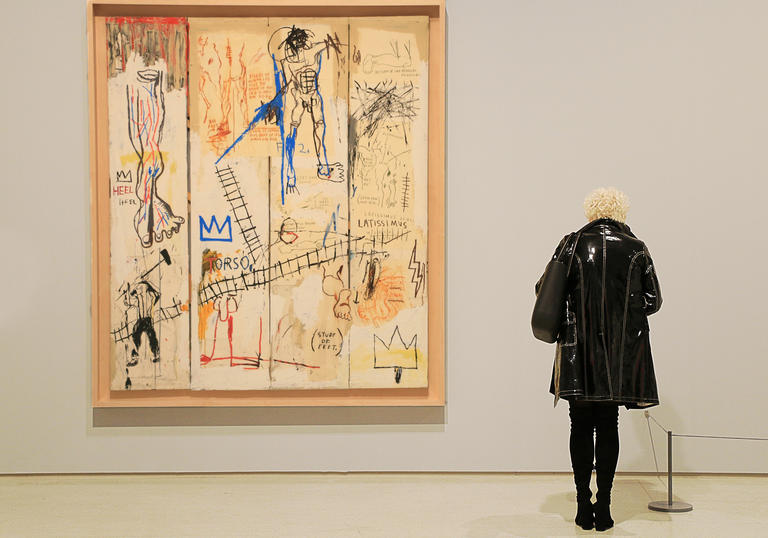Growing up, Basquiat was taken to many of New York’s museums. As a self-taught artist, he remained an avid attendee of exhibitions, whether Cy Twombly’s retrospective at the Whitney in 1979, which became a source of inspiration for his work at New York/New Wave at P.S.1 in February 1981, or the controversial ‘Primitivism’ in 20th Century Art: Affinity of the Tribal and the Modern in 1984, which he attended both at The Museum of Modern Art in New York and when it travelled to the Dallas Museum of Art.
As he explained to Marc Miller in 1983, if he was missing an element for a painting he would sometimes go to the Metropolitan Museum to draw it from life.
The artists he admired also became a source of inspiration in his own works.
Jean-Michel Basquiat, Untitled (Pablo Picasso), 1984
Picasso was one of Basquiat’s most important artistic heroes. ‘PABLO PICASSO’ is written seven times across the canvas, the name repeated as if it were sacred. ‘PICASSO AS A FIFTEEN YEAR OLD’ is inscribed on the subject’s chest, as a reminder that both he and Picasso were considered prodigiously talented at a young age. Although Picasso’s face appears relatively young, he is depicted wearing a striped Breton jumper characteristic of his later years. By conflating these two parts of Picasso’s life Basquiat contemplates the entirety of the artist’s career.
Jean-Michel Basquiat, Leonardo da Vinci’s Greatest Hits, 1982
If you look at the top of the work, Basquiat shares a key source, ‘STUDIES OF HUMAN LEG PLUS THE BONE OF LEG IN MAN AND DOG’ - this relates to a drawing by Leonardo da Vinci from 1506. The delicate chalk and ink form is suggested in the figure sketched in red paint to the left, while the title is echoed in the word ‘HUESO’, Spanish for bone, written twice to the right.
References to limbs appear frequently elsewhere, including ‘CALVES’, which is crossed out and written above backwards, ‘SEVLAC’, in a nod to Leonardo’s mirror writing. In the top right, a kneeling leg is captioned ‘RETURN OF THE PRODIGAL’, a reference to the parable told by Jesus about a profligate son, who seeks forgiveness from his father, demonstrating God’s redemptive grace. Basquiat may have been inspired by Rembrandt’s painting of the story from c. 1665, which was reproduced in his copy of H. W. Janson’s History of Art.
Jean-Michel Basquiat, Matisse Matisse Matisse, 1983
As we saw in the portrait of Picasso, Henri Matisse’s surname is repeated three times at the bottom of the canvas. You’ll also notice several of the French artist’s key themes - the goldfish, the female portrait and Notre Dame. It’s likely these were taken from three works in the collection of The Museum of Modern Art in New York: Goldfish and Sculpture (1912), The Blue Window (1913) and View of Notre Dame (1914). Basquiat visited MoMA from a young age with his mother Matilde, and continued to return to the museum throughout his career.
Basquiat: Boom For Real took place from 21 September–28 January 2018.

